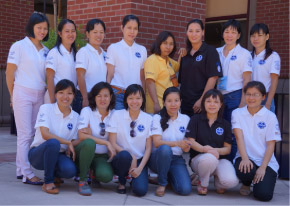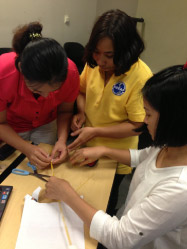The summer of 2013 saw HEEAP’s very first All-Female Vocational Cohort. 14 Female Vietnamese Engineering teachers from Cao Thang Technical College, Ho Chi Minh Vocational College of Technology and the Industrial University of Ho Chi Minh City traveled to Arizona State University, where they spent four weeks completing HEEAP training.
 During their time at ASU, the women were able to learn and practice active teaching methods to better engage their engineering students, as well as English speaking and presenting skills.
During their time at ASU, the women were able to learn and practice active teaching methods to better engage their engineering students, as well as English speaking and presenting skills.
“My HEEAP training will have a lot of meaning for my college,” said Vu Yen Ni, a professor at Cao Thang Technical College’s Information Technology Department. “For example, I will share my experiences with my colleagues, and give them simple advice, and this will improve engagement for students in their classes.”
Thuy Do Thi Bich from Ho Chi Minh Vocational College of Technology’s Electronic and Electrical Engineering Department agreed that the HEEAP program would prove meaningful—not only to her school, but to Vietnam as a whole.
“I think this program is great,” she said. “It can help my country to develop in a lot of ways. I am a teacher, and in my opinion, the teachers should all learn new teaching methods and update their curriculums.”
For Vo Ngoc Yen Phoung from the Industrial University of Ho Chi Minh City, the program’s effect was also widespread.
“It’s improving knowledge of teaching skills for teachers in Vietnam. Not only will I be able to go back and apply my knowledge, but by studying here, I make other teachers curious about HEEAP, and they want to come to the U.S. and participate! I used to see my colleagues participate last year and feel curious,” she said.
 As HEEAP’s first all-female group, the cohort worked not only to improve engineering education in Vietnam, but also to improve women’s place in the world of Vietnamese engineering.
As HEEAP’s first all-female group, the cohort worked not only to improve engineering education in Vietnam, but also to improve women’s place in the world of Vietnamese engineering.
However, with powerful and committed female role models, this is sure to change.
They said that currently, females are underrepresented in their engineering classes. “There are not many female students in my classes. The largest number of female students is 10 out of 80 students total,” Ni said.
“It is not difficult to teach a class of mostly male students because they admire me and see me as a strong role model. I enjoy teaching, students and mechanical engineering. Therefore I concentrate all my ability, love and responsibility into my teaching,” Phuong said. “My female students are a lot like me, and love technology.”
They stressed that differences between men and women add value to the engineering workplace, and that balance is key.
“Men act before they think and women think before they act. Thinking ahead can be a disadvantage, because a lot of time is wasted. However, acting before thinking can cause a lot of mistakes and failed attempts,” Phoung said.
Ni agreed that both men and women bring important skills to any engineering workplace.
“I think women are meticulous, diligent, and intelligent. Anything that a man can do, a woman can do as well. If men can become good engineers, women can also do it,” she said. “Female engineers are important not only in Vietnam, but they are vital for the field of engineering in general.”
Photos:
1. The Cohort poses for a group photo at ASU’s Brickyard.
2. HEEAP faculty members work together to build a marshmallow tower, learning about teaching soft skills through group projects.

